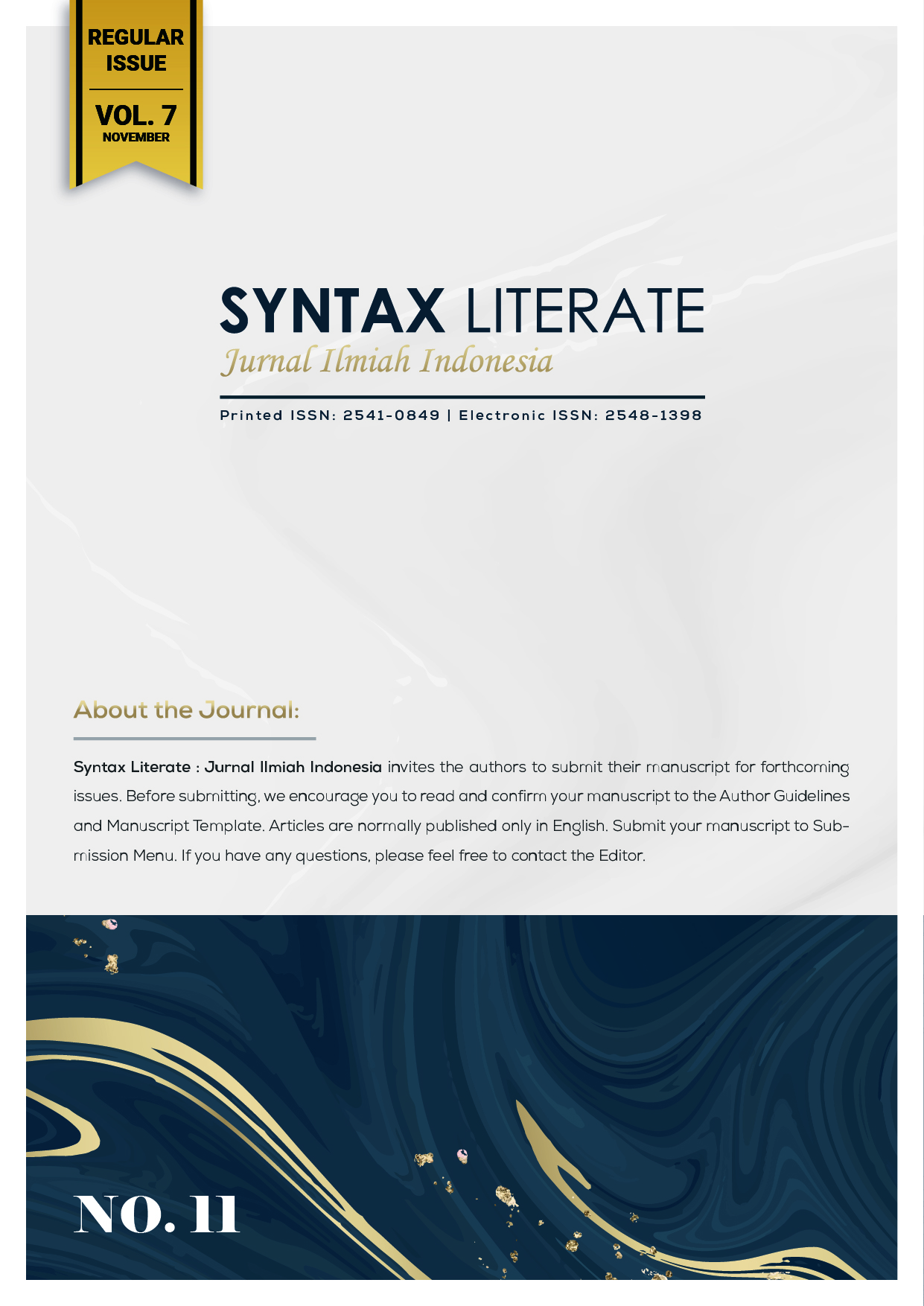Analysis of The Effect of Funding Strategy on The Company's Financial Performance at PT Jasamarga Related Business
Abstract
Business development is the key to ensure the sustainability of a company. The need for funding to support this development makes the company try to obtain a funding strategy that is in accordance with financial performance. Each investment and risk scheme selected will have an impact on the selection of a funding strategy, this is a case study in research to show the effect of the selected funding strategy on financial performance so that companies obtain appropriate alternative funding strategies. This case study uses an in-depth analysis of financial aspects, sensitivity and simulations conducted at PT Jasamarga Related Business. Based on studies conducted, the funding strategy is a priority requirement for the company in developing the company's business strategy. Financial performance is a reflection of the company's sustainability so that all strategy makers, especially the selection of funding strategies, need to be studied more deeply.
Downloads
References
Anna, N., Ridjal, S., & Sjahruddin, H. (2020). Implementasi Financial Projection Sebagai Strategi Pengelolaan Keuangan. Jurnal Ekonomi Dan Bisnis Dharma Andalas, 22(2), 302–314.
Ariwibowo, P., Seto, A. A., Apriyanti, A., Andrianingsih, V., Kusumastuti, R., Yohana, Y., Darmawati, D., Sohilauw, M. I., Musnaini, M., & Melinda, M. (2022). Pengaturan Pengelolaan Keuangan Perusahaan Implementasi Strategi dalam Keputusan Pendanaan dan Pengendalian Keuangan. Eureka Media Aksara.
Bagu, A., Karamoy, H., & Gamaliel, H. (2021). Analisis Faktor-faktor yang Mempengaruhi Pemilihan Pendanaan Struktur Modal Eksternal Pada Perusahaan Industri Manufaktur di Indonesia yang Terdaftar di Bursa Efek Indonesia. JURNAL RISET AKUNTANSI DAN AUDITING" GOODWILL", 12(1), 72–84.
Bender, R. (2013). Corporate Governance and Financial Strategy. Bender, R., Corporate Financial Strategy, 4th Edition, Routledge (2014, Forthcoming).
Budiarti, W., & Hidayati, F. D. (2015). Analisis Perbandingan Pendanaan Aset Tetap Alternatif Leasing Dengan Pinjaman Bank Dalam Efisiensi Pajak Penghasilan Badan (Studi Kasus Pada Pt Cahaya Gasdom). JIAFE (Jurnal Ilmiah Akuntansi Fakultas Ekonomi), 1(2), 94–102.
Dewi, A. P., & Suryani, A. W. (2020). Kebijakan Hutang: Struktur Aset, Profitabilitas dan Peluang Pertumbuhan. Jurnal Bisnis Dan Akuntansi, 22(2), 211–224.
Frank, M. Z., & Goyal, V. K. (2003). Testing the pecking order theory of capital structure. Journal of Financial Economics, 67(2), 217–248.
Grimaldi, R., & Grandi, A. (2005). Business incubators and new venture creation: an assessment of incubating models. Technovation, 25(2), 111–121.
Ispriyahadi, H., & Abdulah, B. (2021). Analysis of The Effect of Profitability, Leverage and Firm Size on Firm Value. Journal of Business, Management, & Accounting, 3(2), 64–80.
Izfs, R. D., & Supriatna, N. (2019). Pengaruh Initial Public Offering (IPO) Terhadap Kinerja Perusahaan. Jurnal Riset Akuntansi Dan Keuangan, 7(1), 19–28.
Jensen, M., & Meckling, W. (1976). Theory of The Firm: Managerial Behavior, Agency Costs, and Ownership Structure. Journal of Financial Economics, 3, 305–360.
Kristianti, I. P. (2018). Analisis pengaruh struktur modal terhadap kinerja keuangan perusahaan. Jurnal Akuntansi Dewantara, 2(1), 56–68.
Listyawati, R., & Wicaksana, F. G. (2023). Investment Decisions, Funding Decisions and Activity Ratios on Firm Value in Indonesia. Kajian Bisnis Sekolah Tinggi Ilmu Ekonomi Widya Wiwaha, 31(1), 65–80.
Ma, L., Huang, Y., Song, Z., Feng, S., Tian, X., Du, W., Qiu, X., Heese, K., & Wu, M. (2006). Livin promotes Smac/DIABLO degradation by ubiquitin–proteasome pathway. Cell Death & Differentiation, 13(12), 2079–2088.
Niresh, A., & Thirunavukkarasu, V. (2014). Firm size and profitability: A study of listed manufacturing firms in Sri Lanka. International Journal of Business and Management, 9(4).
Pastusiak, R., Bolek, M., Malaczewski, M., & Kacprzyk, M. (2016). Company Profitability Before and After IPO. Is it a Windows Dressing or Equity Dilution Effect? Prague Economic Papers, 25(1), 112–124.
Petty, J. W., Titman, S., Keown, A. J., Martin, P., Martin, J. D., & Burrow, M. (2015). Financial management: Principles and applications. Pearson Higher Education AU.
Rajan, R. G., & Zingales, L. (1995). What do we know about capital structure? Some evidence from international data. The Journal of Finance, 50(5), 1421–1460.
Ramdhonah, Z., Solikin, I., & Sari, M. (2019). Pengaruh Struktur Modal, Ukuran Perusahaan, Pertumbuhan Perusahaan, Dan Profitabilitas Terhadap Nilai Perusahaan (Studi Empiris Pada Perusahaan Sektor Pertambangan Yang Terdaftar Di Bursa Efek Indonesia Tahun 2011-2017). Jurnal Riset Akuntansi Dan Keuangan, 7(1), 67–82.
Ratih, D. (2021). Equity market timing and capital structure: evidence on post-IPO firms in Indonesia. International Journal of Emerging Markets, 16(2), 391–407.
Santoso, A. F., & Pudjolaksono, E. (2014). Pengaruh Good Corporate Governance Terhadap Earnings Management Pada Badan USAha Sektor Property Dan Real Estate Yang Terdaftar Di Bei Periode 2009–2012. Calyptra, 2(2), 1–20.
Sen, M., & Eda, O. (2008). Testing of pecking-order theory in Istanbul stock exchange market. International Research Journal of Finance and Economics, 21, 1450–2887.
Sun, W., Yao, S., & Govind, R. (2019). Reexamining corporate social responsibility and shareholder value: The inverted-U-shaped relationship and the moderation of marketing capability. Journal of Business Ethics, 160, 1001–1017.
Suprianto, S., Arhas, S. H., Mahmuddin, M., & Siagian, A. O. (2020). The effectiveness of online learning amid the COVID-19 pandemic. Suprianto Jurnal Ad’ministrare.
Turner, G. (2010). Approaching celebrity studies. Celebrity Studies, 1(1), 11–20.
ValanÄienÄ—, L., & JegeleviÄiÅ«tÄ—, S. (2014). Crowdfunding for creating value: stakeholder approach. Procedia-Social and Behavioral Sciences, 156, 599–604.
Van Duuren, E., Plantinga, A., & Scholtens, B. (2016). ESG integration and the investment management process: Fundamental investing reinvented. Journal of Business Ethics, 138, 525–533.
Vuorikari, M. (2012). Optimizing working capital management from processes perspective.
Copyright (c) 2022 Ria Marlinda Paallo, Eka Pria Anas

This work is licensed under a Creative Commons Attribution-ShareAlike 4.0 International License.











